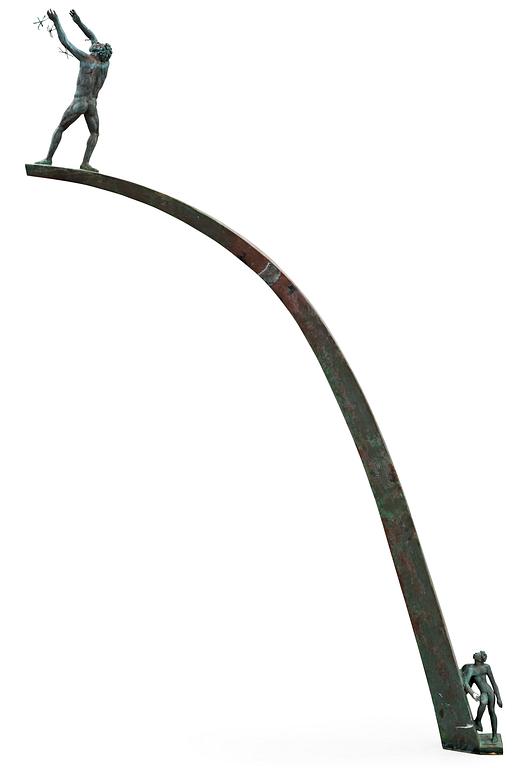Carl Milles
"Gud på himmelsbågen" (The Rainbow. Lord placing new stars on heaven)
Signed Carl Milles. Foundry mark Gunnar Pettersson Fud. Bronze, green patina. Height 330 cm.
Alkuperä - Provenienssi
Axel Linds Kunstmuseum Grenen, Skagen, Denmark.
Kirjallisuus
Henrik Cornell, "Carl Milles - hans verk", 1957, page 163-169.
Editor Eva and Axel Lind," Grenen Kunstmuseum, Skagen",1977, with picture at page 5 and 43, mentioned at page 74 and with picture full page 75.
Erik Näslund, "Carl Milles - en biografi", 1991, compare page 304-305 and 307.
Editor Axel Lind, "Grenen Kunstmuseum - 20 års jubileumskatalog", 1998, the lot at the auction with picture and mentioned at page 25.
Muut tiedot
Milles spent two decades in the USA where he went through several different phases in his production. He moved there in 1931 and became a professor at Cranbrook Academy of Art in Michigan. While he had his international breakthrough earlier, the move led him to became well-known in America. He became especially popular for his large works which he did in the 1940s and 50s, like ”The Resurrection Fountain” in Washington or the Delaware Monument in Wilmington. Another great work from this time is "The Rainbow. Lord placing new stars on heaven" which Milles produced between 1946 to 1947. The sculpture, in this lot, is a study of the proposal for the peace monument that Milles created for the United Nations building in Manhattan in New York. It was originally supposed to be ten times its original size with water flowing from its top into the East River to create an arch that would connect the sculpture with the water. The secretary general of the United Nations at the time, Tryggve Lie, commissioned the proposal, but it was never executed to its full scale. The sculpture was meant to be a symbol of peace and a tribute to the founding of the United Nations.
There is a three-meter high study in Millesgården, Stockholm, Sweden. There is also an eighteen-meter version in Nacka Strand, Stockholm, that was finalized by the artist Marshall M Frederick, who was an assistant to Milles. Frederick based his work on Milles's original sketches and studies. In one version, God stands in a mantel, while in another sketch, God is assisted by a whole army of angels that hovers around him. But in the final piece, Milles purified it to an impressive, simple form that was typical for most of his greatest works. The arch symbolizes heaven and at its base, an angel stands and gives the Creator the stars that he will place in heaven. The idea of form, however, was not new to Milles. He had created a peace monument before, "Visions of Peace" in 1936, where the motive with a figure on an arch placing the stars, is present in a relief. The sculpture is placed in Sain Paul City Hall in Minnesota, USA. Carl Milles's biographer Henrik Cornell describes "The Rainbow. Lord placing new stars on heaven" as: "the spiritualization of the sculpture that he aimed for, during his last decades more and more, had here made realized to a greater extent, more original, and for him, more significantly than in any other of his works."











































